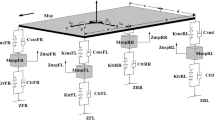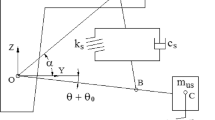Abstract
This paper presents ride comfort and driving stability performances of electronic control suspension (ECS) equipped with controllable electrorheological (ER) damper and appropriate control strategy. In order to achieve this goal, a cylindrical type ER damper which is applicable to Macpherson strut type suspension of a mid-sized passenger vehicle is designed and manufactured on the basis of the required damping force level of an existing passenger vehicle. After experimentally evaluating the field-dependent damping force and dynamic characteristics of the controllable ER damper, ECS consisting of sprung mass, spring, tire and controller is established in order to investigate the ride comfort and driving stability performances. On the basis of the governing equation of motion of the suspension system, five control strategies (soft, hard, comfort, sports and optimal mode) are formulated. The proposed control strategies are then experimentally realized with the quarter-vehicle ECS system. Control performances such as vertical acceleration of the car body and tire deflection are evaluated in both time and frequency domains under various road conditions. In addition, a comparative work is undertaken to investigate inherent control characteristics of each control strategy.

















Similar content being viewed by others
References
Gillespie TD (1992) Fundamentals of vehicle dynamics. Society of Automotive Engineers, Warrendale
Elbeheiry EM, Karnopp DC, Elaraby ME, Abdelraaouf AM (1995) Advanced ground vehicle suspension systems—a classified bibliography. Veh Syst Dyn 24:231–258
Nakano M (1995) A novel semi-active control of automotive suspension using an electrorheological shock absorber. In: Proceedings of the 5th international conference on ER fluid, MR suspensions and associated technology (Sheffield), pp 645–653
Sims ND, Stanway R, Beck SBM (1997) Proportional feedback control of an electro-rheological vibration damper. Journal of Intelligent Material Systems and Structures 8:426–433
Petek NK, Romstadt DJ, Lizell MB, Weyenberg TR (1995) Demonstration of an automotive semi-active suspension using electrorheological fluid. SAE Technical Paper Series 950586
Gordaninejad F, Ray A, Wang H (1997) Control of forced vibration using multi-electrode electro-rheological fluid dampers. J Vib Acoust 119:527–531
Choi SB, Choi YT, Chang EG, Hang SJ, Kim CS (1998) Control characteristics of a continuously variable ER damper. Mechatronics 8:143–161
Choi SB, Choi YT, Park DW (2000) A sliding mode control of a full-car electrorheological suspension system via hardware-in-the-loop simulation. J Dyn Syst, Meas, Control 122:114–121
Nquyen QH, Choi SB (2009) A new approach for dynamic modeling of electrorheological damper using lumped parameter method. Smart Mater Struct 18:1–11
Choi SB, Sung KG (2008) Control of braking force distribution using electrorheological fluid valves. Int J Veh Des 46:111–127
Han YM, Nquyen QH, Choi SB (2009) Unsteady flow modeling of an electrorheological valve system with experimental validation. Smart Mater Struct 18:1–9
Williams EW, Rigby SG, Sproston JL, Stanway R (1993) Electrorheological fluids applied to an automotive engine mount. J Non-Newton Fluid Mech 47:221–238
Hong SR, Choi SB, Lee DY (2006) Comparison of vibration control performance between flow and squeeze mode ER mounts: experimental work. J Sound Vib 291:740–748
Johnson AR, Bullough WA, Makin J (1999) Dynamic simulation and performance of an electro-rheological clutch based reciprocating mechanism. Smart Mater Struct 8:591–600
Han YM, Choi SB (2008) Control of ER haptic master in virtual slave environment for minimally invasive surgery application. Smart Mater Struct 17:1–10
Choi SB, Choi YT, Park DW (2000) A sliding mode control of a full-car electrorheological suspension system via hardware-in-the-loop simulation. J Dyn Syst, Meas, Control 122(1):114–121
White FM (1994) Fluid mechanics. McGraw-Hill, New York
Nigam NC, Narayanan S (1994) Applications of random vibrations. Springer, New York
International Organization for Standardization (1997) Mechanical vibration and shock—evaluation of human exposure to whole-body vibration. ISO2631-1:1997
Lin KY, Hwang JR, Chang SH, Fung CP, Chang JM (2006) System dynamics and ride quality assessment of automobile. Society Automotive Engineering, 2006-01-1225
Acknowledgements
This work was partially supported by the National Research Foundation of Korea (NRF) grant funded by the Korea government (MEST) (No. 2010-0015090).
Author information
Authors and Affiliations
Corresponding author
Rights and permissions
About this article
Cite this article
Sung, KG., Seong, MS. & Choi, SB. Performance evaluation of electronic control suspension featuring vehicle ER dampers. Meccanica 48, 121–134 (2013). https://doi.org/10.1007/s11012-012-9588-4
Received:
Accepted:
Published:
Issue Date:
DOI: https://doi.org/10.1007/s11012-012-9588-4




